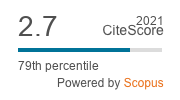Using intelligent optimization algorithms, determine the quality of the nitrogenous base substituted for the MT-ND5 gene sequence
Keywords:
MT-ND5 gene, Ant colony optimization(ACO), Hidden Markov Model (HMM).Abstract
This paper focuses on the application of intelligent optimization techniques in genetic engineering, using the MT-ND5 gene sequence as a case study to determine the specificity of nitrogenous base substitution. We used data from the NCBI database and analyzed it using smart optimization algorithms for the mathematical model of the objective function of the type of dynamic programming that comes from the hidden Markov chain to find the chance of getting a true sequence that is highest. We compared the results with the intelligent methods, demonstrating the effectiveness of these solutions in speeding up and enhancing the accuracy of the analysis through MATLAB simulations.
References
Chakraborty, A., and A. K. Kar. “Swarm Intelligence: A Review of Algorithms.” Nature-Inspired Computing and Optimization: Theory and Applications, 2017, pp. 475–494.
Churbanov, A., and S. Winters-Hilt. “Implementing EM and Viterbi Algorithms for Hidden Markov Model in Linear Memory.” BMC Bioinformatics, vol. 9, no. 1, 2008, pp. 1–15, https://doi.org/10.1186/1471-2105-9-1.
Forney, G. D. “The Viterbi Algorithm.” Proceedings of the IEEE, vol. 61, no. 3, 1973, pp. 268–278,https://doi.org/10.1109/PROC.1973.9030.
Gad, A. G. “Particle Swarm Optimization Algorithm and Its Applications: A Systematic Review.” Archives of Computational Methods in Engineering, vol. 29, no. 5, 2022, pp. 2531–2561, https://doi.org/10.1007/s11831-021-09645-0.
Grzybowska-Szatkowska, L., and B. Ślaska. “Mitochondrial NADH Dehydrogenase Polymorphisms Are Associated with Breast Cancer in Poland.” Journal of Applied Genetics, vol. 55, no. 2, 2014, pp. 173–181, https://doi.org/10.1007/s13353-013-0182-3.
Ibrahim, M. K., et al. “Bioinspired Algorithms for Multiple Sequence Alignment: A Systematic Review and Roadmap.” Applied Sciences, vol. 14, no. 6, 2024, p. 2433, https://doi.org/10.3390/app14062433
Kloss-Brandstätter, A., et al. “HaploGrep: A Fast and Reliable Algorithm for Automatic Classification of Mitochondrial DNA Haplogroups.” Human Mutation, vol. 32, no. 1, 2011, pp. 25–32, https://doi.org/10.1002/humu.21382.
Lee, W., P. Yue, and Z. Zhang. “Analytical Methods for Inferring Functional Effects of Single Base Pair Substitutions in
Human Cancers.” Human Genetics, vol. 126, no. 3, 2009, pp. 481–498, https://doi.org/10.1007/s00439-009-0674-2
Martin-Navarro, A., et al. “Machine Learning Classifier for Identification of Damaging Missense Mutations Exclusive to Human Mitochondrial DNA-Encoded Polypeptides.” BMC Bioinformatics, vol. 18, no. 1, 2017, pp. 1–11, https://doi.org/10.1186/s12859-017-1750-6
Rabiner, L., and B. Juang. “An Introduction to Hidden Markov Models.” IEEE ASSP Magazine, vol. 3, no. 1, 1986, pp. 4–16, https://doi.org/10.1109/MASSP.1986.1165342
Verge, B., et al. “Mitochondrial DNA (mtDNA) and Schizophrenia.” European Psychiatry, vol. 26, no. 1, 2011, pp. 45–56, https://doi.org/10.1016/j.eurpsy.2010.01.012
Abdullah, Dahlan. “Enhancing Cybersecurity in Electronic Communication Systems: New Approaches and Technologies.” Progress in Electronics and Communication Engineering 1(1) (2024): 38–43.
Prasath, C. Arun. “Cutting-Edge Developments in Artificial Intelligence for Autonomous Systems.” Innovative Reviews in Engineering and Science 1(1) (2024): 11–15.
Udhayakumar, A., et al. “Reversible Vedic Direct Flag Divider in Key Generation of RSA Cryptography.” Journal of VLSI Circuits and Systems 6(2) (2024): 75–83.
Rahim, Robbi. “Scalable Architectures for Real-Time Data Processing in IoT-Enabled Wireless Sensor Networks.” Journal of Wireless Sensor Networks and IoT 1(1) (2024): 28–31.
Cao, S., Yang, H., Lu, S., and Qian, F. “Fine Tuning SSP Algorithms for MIMO Antenna Systems for Higher Throughputs and Lesser Interferences.” International Journal of Communication and Computer Technologies, vol. 12, no. 2, 2024, pp. 1–10.
Surendar, A. “Internet of Medical Things (IoMT): Challenges and Innovations in Embedded System Design.” SCCTS Journal of Embedded Systems Design and Applications 1(1) (2024): 33–36.




